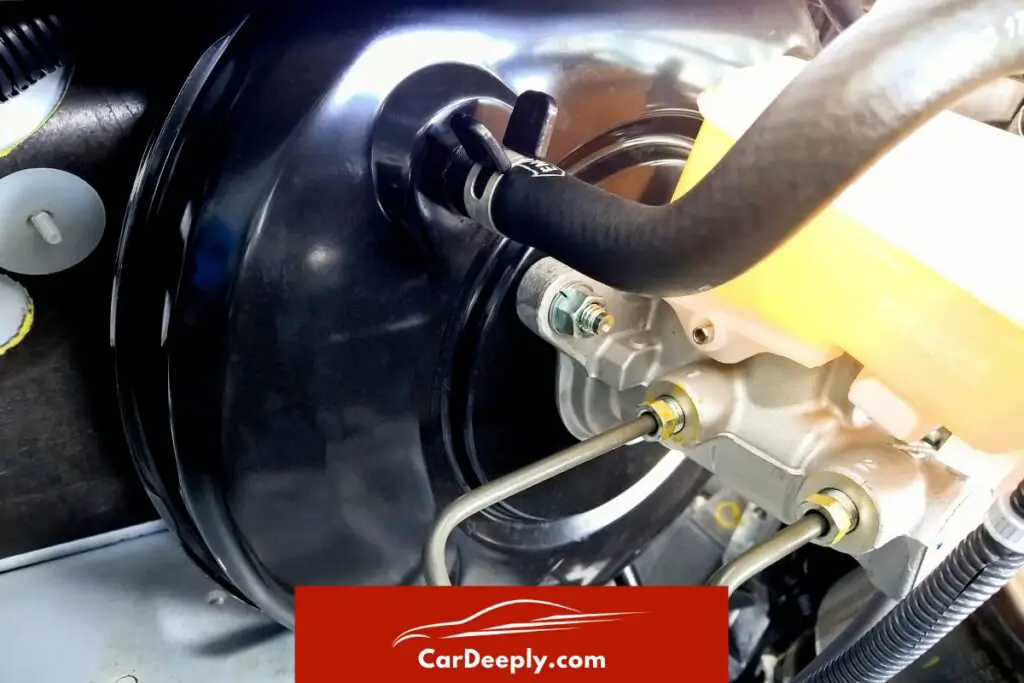The function of a brake booster in your F-150 is to give the braking system power assistance, which makes it possible to apply the brakes with less force.
Knowing the typical signs of a faulty brake booster might help you detect a problem before it threatens your car’s safety.
In this article, learn how to tell if your brake booster is bad, what the signs are, and why it is such an essential piece in your F-150.
Advertising links are marked with *. We receive a small commission on sales, nothing changes for you.
Bad Brake Booster In F-150: Key Takeaways

Signs that your brake booster is bad:
- A lousy engine performance,
- high brake pedal position,
- a long stopping distance,
- a tight brake pedal action.
How To Tell If Brake Booster Is Bad?
A booster, vacuum line, and fittings are part of the standard power braking system on your Ford F-150. When slowing down or stopping your truck, this mechanism considerably improves the amount of pressure that can be applied to the brake pedal.
The vacuum pipe that connects the engine to the booster, however, it may harden, split, or bulge overtime before eventually leaking. Additionally, the device might become inoperable due to the internal diaphragm of the booster rupturing or another component wearing out.
Perform two quick tests at home without using any equipment to determine the state of the brake booster in your F-150.
Step 1. Engage The Parking Brake
Your F-150’s parking brake should be engaged, but the brake pedal should not be touched.
Step 2. Start Your Engine
Your F-150’s engine should be started and allowed to idle without using the brakes.
Step 3. Let The Engine Run & Then Turn It Off
Before moving on to the following procedure, let the engine idle for one minute, then turn off the ignition and wait another minute.
Step 4. Monitor Pedal Movements
Repeatedly depress and release the brake pedal while monitoring the pedal’s movement as you step on it. The amount of pedal travel should start to decrease with each application. This is a sign that the engine is providing suction assistance to the brake booster. If not, inspect the booster itself, the hose fittings, and the booster vacuum hose for vacuum leaks.
Step 5. Make Sure The Vacuum Is Released From the System
To confirm that the vacuum has been released from the system, depress and release the brake pedal repeatedly until the pedal travel stays the same.
Step 6. Check If Power Booster Is Operating As It Should
According to It Still Runs, you should now slightly depress the brake pedal without using excessive force, and keep the pedal pressed down all the while. Start the engine and let it idle simultaneously. The brake pedal should begin to go down and toward the floor when the engine begins. This indicates that the power booster is operating as intended. If not, bring your F-150 to a mechanic to check it out and change the booster if required.
What Are The Symptoms Of A Bad Brake Booster In F-150?
There are a few signs that your brake booster in F-150 is not working properly. If that’s the case, you have to fix it before it becomes a much bigger problem.
In the next few paragraphs, you will see some usual signs that you have a bad brake booster in your F-150 truck.
Brake Pedal Action Is Tight
Pushing the brake pedal with a poor brake booster is significantly more difficult.
The booster ability to exert extra pressure against the master cylinder piston diminishes as it breaks down. You must now apply the whole braking force, which is a challenging undertaking.
Longer Stopping Distance
A brake booster may occasionally degrade gradually, making the performance change challenging to detect. Have the brakes examined if you feel you need to brake more quickly than you should to stop the vehicle.
The brake booster may be blamed if the pads and rotors appear in good condition.
High Brake Pedal Position
You could notice that the brake pedal “travels” less than usual when the brakes are used, alongside the pedal’s harsher resistance to pressure.
The pedal return might be more sluggish than it is usually if the booster chambers are out of balance.
Poor Engine Performance
The booster draws air into the induction system through a hole in the diaphragm. Due to the booster’s link to the primary air intake, this circumstance may impact the fuel mixture in the engine.
This reduces fuel economy in more recent fuel-injected automobiles since the computer makes up for the discrepancy. Failure of the brake booster in an older vehicle may result in the engine running low and with inadequate fuel in the cylinders.
Without the entire cooling effect of the right amount of gas, engine parts heat up and become more prone to friction, which can cause pre-ignition (the gasoline ignites before the spark plug fires).
This may be perceived as a lack of engine power or heard as pinging. Pre-ignition, if allowed to continue, might result in burnt valves or damaged pistons, necessitating an expensive repair.
Why Is Brake Booster In F-150 Important?
The brake booster is crucial for an automobile with disc brakes to stop. The component, which is under the hood, gives your car’s brakes more power and helps you stop it.
Without it, stopping distances would significantly lengthen, increasing the likelihood of an accident during an emergency stop for the driver and passengers.
How Does Brake Booster In F-150 Work?
The vacuum created by air rushing into the engine through the air intake causes a reduction in pressure between the brake booster’s two chambers, which are divided by a diaphragm. A valve opens when the brake pedal is pressed, allowing air to enter the booster on one side. This enables the vacuum to pull on the diaphragm on the other side.
On its route to the master cylinder piston, a rod that is connected to the brake pedal assembly passes through the diaphragm’s center.
The diaphragm pulls on the rod and increases the force exerted against the master cylinder piston as the rod transfers the force delivered to the brake pedal. The combined force simply and swiftly slows down the automobile. The valve shuts when the brake pedal is released, bringing the system back into equilibrium.
Do something as soon as you notice any of the following faulty brake booster signs; don’t ignore them. They show that driving in your automobile is now dangerous.

Luna Meschiari is a full-blooded car nut who is well known to local garages, as each article is meticulously researched and peppered with the latest piece of information. Guess what car she’s driving right now? A RAV4 2021 Hybrid. But her heart also sleeps for pickups like the F-150. Get to know Luna better on the about us page.
Advertising links are marked with *. We receive a small commission on sales, nothing changes for you.
